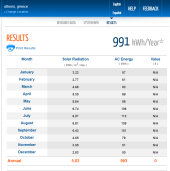i all I am a total novice to this and am trying to setup my first system.
I have;
2 solar panels 150W each/ VOC 21.5 max power volt is 18V
2 solar panels 200W each/ VOC 19.2 max power volt is 16V and 12v/24v 60A Controller
and a wind turbine which is as follows;
Specifications: Leaf material: nylon fiber Generator case: Casting aluminum alloy Colour: white+blue Wind wheel diameter:1.25m Blade length:0.6m Weight:9kg Power:3000W Rated voltage: 12/24V Starting wind speed:2.0m/s Rated wind speed: 11.5m/s Safe wind speed: 55m/s Number of leaves: 5PCS Control system: Electromagnet/wind wheel yaw Wind direction adjustment: automatic adjustment of the wind Wind power and type: three-phase AC permanent magnet synchronous generator Operating temperature: -40℃~+80℃
and a 12000W DC 24V to AC 230V Brand New Pure Sine Waveinverter
my requirements
can someone please assist me with what size batteries and which inverter / controller to use to hook all this up. Possibly a diagram with fuses and whatever else is needed would be greatly appreciated
I have;
2 solar panels 150W each/ VOC 21.5 max power volt is 18V
2 solar panels 200W each/ VOC 19.2 max power volt is 16V and 12v/24v 60A Controller
and a wind turbine which is as follows;
Specifications: Leaf material: nylon fiber Generator case: Casting aluminum alloy Colour: white+blue Wind wheel diameter:1.25m Blade length:0.6m Weight:9kg Power:3000W Rated voltage: 12/24V Starting wind speed:2.0m/s Rated wind speed: 11.5m/s Safe wind speed: 55m/s Number of leaves: 5PCS Control system: Electromagnet/wind wheel yaw Wind direction adjustment: automatic adjustment of the wind Wind power and type: three-phase AC permanent magnet synchronous generator Operating temperature: -40℃~+80℃
and a 12000W DC 24V to AC 230V Brand New Pure Sine Waveinverter
my requirements
| ITEMS | Rated Watts | Hours to run daily | 1 days energy requirement | days without energy input | Working Hours Whr |
| Fridge | 200 | 24 | 4800 | 3 | 14400 |
| A/C 12000 | 1300 | 5 | 6500 | 3 | 19500 |
| A/C24000 | 2800 | 5 | 14000 | 3 | 42000 |
| Lights14 | 500 | 7 | 3500 | 3 | 10500 |
| Oven | 2000 | 3 | 6000 | 3 | 18000 |
| Water Heater | 2500 | 1 | 2500 | 3 | 7500 |
| TV Sony 37 | 100 | 8 | 800 | 3 | 2400 |
| TV LG 24 | 30 | 5 | 150 | 3 | 450 |
| Tablet 10" | 30 | 4 | 120 | 3 | 360 |
| Cell | 10 | 2 | 20 | 3 | 60 |
| TOTAL | 9470 | 38390 | 3 | 115170 |
can someone please assist me with what size batteries and which inverter / controller to use to hook all this up. Possibly a diagram with fuses and whatever else is needed would be greatly appreciated
Last edited:




